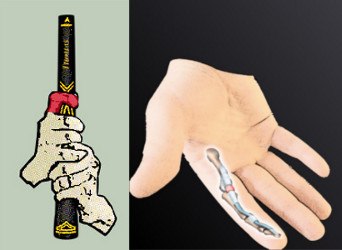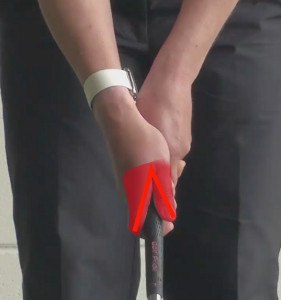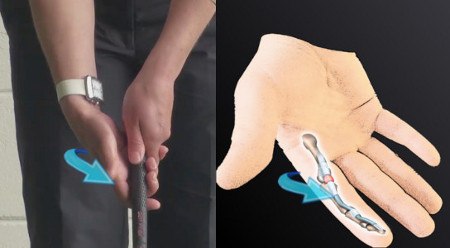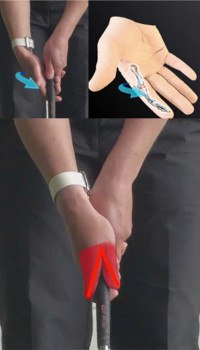
Look at the bottom hand of any good golfer as he grips the club at address and you'll notice a small gap between the index finger and middle finger. In fact, the index finger looks much like it would if squeezing the trigger of a gun.
Hence, the term “trigger finger.”
This slight separation may seem minor, but it plays a key role in your ability to control the club. In forming a proper trigger finger position, you give the club a cradle in which to rest at the top of the backswing, preventing the club from wobbling as you transition to the downswing. Keeping a small amount of pressure on the middle joint of the trigger finger improves your feel for the clubhead, too, helping you square the face through impact.

To grip the club correctly with your bottom index finger (right hand for righties), follow these simple steps:
- Assume your regular grip, with your right thumb forming a diagonal line across the handle.
- Hook the right index finger around the bottom of the club so that there's about a quarter-inch separating it from the middle finger.
- You should see a “V” formed by the right thumb and right forefinger from the first knuckle to its base.
This configuration will also keep you from placing too much of the handle in your palms. If the right index finger forms a circle from tip to base, around the club, it's a tell-tale sign that you're palming it.

Golf Grip – What is the Trigger Finger?
The success or failure of your golf shots is mostly determined before you even put the club into motion. While that fact is hard for many amateur golfers to understand, it is absolutely true – if you get everything right in terms of your pre-shot setup, you will be well on your way to a positive outcome. You still have to make a quality swing, of course, but most of the hard work will already be completed when you take a good stance and form a good grip. Those might seem like easy points, but few amateur golfers actually get them right on a regular basis. Take the time to create quality pre-shot fundamentals in your game and you will be surprised to see how quickly you can improve.
In this article, we are going to look at a seemingly subtle part of the grip. Specifically, we are going to address the 'trigger finger' position that you should form with the pointer finger on your right hand (for a right handed golfer). Using a trigger finger grip – meaning your pointer finger is separated slightly from the rest of your fingers as it wraps around the grip – is a great way to add to your feel for the club. There are a number of benefits that come along with using this technique, and really no drawbacks to speak of. As an added bonus, this isn't a position that should take you very long to comfortable with, so you can put it into action and see results almost immediately.
While the grip is a highly personal thing, and there are plenty of different grips that have led to quality ball striking over the years, there is an argument to be made that all golfers should use the trigger finger. At the very least, you should give this style of grip a try to see if it is able to help improve the consistency of your swing. You want to have control over the golf club at all points during the swing, and the trigger finger might be able to help you toward that goal.
It is often true that the best tips in the game of golf are the simple ones, and they don't come much more simple than the idea of moving your pointer finger slightly down the grip and away from the rest of your fingers. You don't need to understand any complicated swing theory in order to put this tip into action – you can simply adjust the positioning of your finger and start swinging away. Of course, even though this is a simple change, it is not something that should be tested out for the first time on the golf course. Try hitting some shots with a trigger finger grip while on the driving range and take it out to the course after you have had a chance to get comfortable.
All of the content below has been written from the perspective of a right handed golfer. If you are a left handed player, please take a moment to reverse the directions as necessary. Obviously, for left handed players, the trigger finger is going to refer to the pointer finger on the left hand, as opposed to the right pointer finger for a right handed player.

Control at the Top
One of the key moments that takes place in the golf swing is the transition between the backswing and the downswing. As you change directions at the top, it is easy to lose control of your swing – which can obviously lead to problems when you get back down to the bottom to actually contact the ball. Many amateur golfers allow the club to 'wobble' at the top, which is often the result of a poor grip that doesn't put the fingers in the right position to control the shaft. To correct this problem, you may want to try using the trigger finger grip. Moving your right pointer finger just a bit down the grip will add to the control you have over the club, meaning your swing will be more stable as it transitions from backswing to downswing.
If there are problems present at the top of your swing, those problems can be manifested in a number of different ways when it comes to your ball flight. For instance, allowing the club to drop during the transition will put it under the proper swing plane, leaving you vulnerable for a quick hook or a push out to the right. Or, if you avoid dropping the club inside by pushing it up away from your shoulder, you will end up over top of the right plane and you will have to attack the ball from the outside. This is the classic slice pattern, although it can also create a pull if your hands are active through the hitting area. Either way, losing control of your swing plane at the top is almost sure to lead to a shot that flies off line significantly.
The best golf swings tend to be those which are controlled more by the body than the hands and arms, which is exactly what will happen in your game when you employ the trigger finger grip. Believe it or not, making this adjustment in your grip is a great way to quiet the action of your hands during the swing. You will have a greater degree of control over the club with this kind of grip, meaning the club won't be so quick to respond to subtle moves in your hands and wrists. Now that the club is steadier throughout the swing, you can focus on using the rotation of your body to propel the club through the hitting area. This is a powerful way to play the game, and you are likely to find that you quickly fall in love with how solid your swing feels while putting the trigger finger to use.
Getting back to the topic of the top of the swing, another benefit of the trigger finger grip is avoiding the extra-long backswing that dooms the swing of so many amateur players. The average golfer thinks they need to make a long swing in order to hit powerful shots, but going too far in this effort is only going to harm your swing in the end. You want to make a full shoulder rotation, but adding length to your arm swing at the top will make it difficult to strike the ball cleanly. By using the trigger finger, you will be giving the club a place to 'rest' at the top, and you will be less-inclined to swing too far beyond an appropriate backswing length. Use your rotation to form a full backswing while you keep your hands steady to make sure the club stops right around the parallel position at the top.
Controlling the club at the top of the swing should be one of your top motivations for using the trigger finger grip. After only a few practice swings, you should begin to notice the difference in the way the club is transitioning at the top, assuming you have been using a grip that did not feature a trigger finger position. You will now be able to use your lower body more aggressively in the downswing, which is exactly what you should be doing in order to generate power through the hitting area. It can be hard to believe that such a small change can make such an important difference in your swing, but don't dismiss this idea until you have tried it for yourself.

Stability Through the Hit
One of the important parts of the golf swing that doesn't get talked about often enough is the ability to keep the club stable through the hitting area. Any way you look at it, the moment of impact is a violent collision between the club head and the ball. Powerful players can swing the club through impact at more than 100 miles per hour, which is obviously more than enough force to create quite a bit of energy when the collision occurs. While you would love to have each and every impact with the ball come right off the middle of the club face, that obviously isn't going to happen. You are going to miss-hit the majority of your shots, so your ability to hold the face stable when that happens will have a lot to do with how you score.
There are a number of factors that contribute to your ability to hold the face steady at impact. One is the strength that you have in your hands and forearms. Players with plenty of strength in the small muscles of the hands and forearms generally have an easier time holding the face steady. This strength pays off on all shots, but it really comes in handy when playing out of the rough. The long grass found in the rough wants to stop and twist the club, and it takes plenty of strength to fight off those forces.
Another factor in this equation is the grip that you choose to use on the club, which is where the trigger finger comes into the picture. By using a trigger finger positioning on the grip, you are effectively spreading out your right hand – meaning you are covering more of the grip with your hand. In turn, you will be able to hold the club in a steadier position through impact due to the fact that you have more of the club directly under your control. It will be harder for the club head to twist simply because your hands will have an added degree of security on the grip. This is another point that might seem subtle and small, but it can pay off in a big way when you are able to carve the ball out of the rough while keeping the face square to your target.
Once you are able to put the trigger finger to use in your game, and you start to feel an increased sense of control at impact as a result, you will love the way your confidence grows on all different kinds of shots around the course. It is a great feeling to know that you are going to be able to hold the club steady through the hit, as this is not a feeling that most players are able to enjoy – and you may have not felt it previously during your golf career. You will find that more of your shots start to fly on line once you make this adjustment, and those shots will also hold their line better once in the air. Simply put, you should be a better ball striker due to adding a trigger finger to your grip.

Other Key Grip Points
Yes – using the trigger finger position can be tremendously helpful in the way your grip works during the swing. However, it is not the only point that needs to be considered while putting together your grip. In fact, you can still get the grip quite wrong despite the presence of a trigger finger if you fail to hit on the other key fundamentals. With that in mind, it is important to highlight some of the other points that you should be watching for in your swing beyond the trigger finger. Make sure you are hitting on all of the points below when forming your grip and you will be on the right track.
- Soft grip pressure. This is the number one key when it comes to the grip that you use in your golf game. Squeezing the grip too tightly is an extremely common problem, and it makes it difficult to swing the club freely through the hitting area. If you are struggling to create power and consistency in your swing, checking on your grip pressure is one of the first things you should do. Proper grip pressure is actually quite simple, despite the fact that many golfers get it wrong. Your goal should be to use a grip that is just tight enough to allow you to keep control over the club, and no tighter. You obviously need to control the club through the hitting area – and you certainly don't want the club to go flying out of your hands at any time – but you don't want to hang on so tight that the club is not allowed to move freely. Practice using a soft grip pressure while working on your short game and gradually move into longer and longer swings until you are comfortable hitting your driver while squeezing the grip just the right amount.
- Fingers, not palm. When placed in your hands, the grip of the club should be running along the base of your fingers, rather than running up into your palm. Putting the grip into the palm of the hands is a classic beginner's mistake, and the result is a swing that looks stiff and uncomfortable. You need to be able to engage your hands and wrists in the swing in order to generate speed, but that will be nearly impossible when you put the grip into your palm. By putting the handle of the club into your palms, you will be 'locking up' your wrists, and you will have a hard time making a free swing as a result. This is one of those points in the game of golf that is not up for debate. There are plenty of unique and individual aspects to golf swings even at the highest levels of the game, but you aren't going to see any pro players swinging the club with the handle in their palms. Keep the club down near the base of your fingers and enjoy the freedom that this type of grip provides.
- Find the right grip strength. In golf, grip strength refers not to how tightly you hold on to the handle, but rather to the position of your left hand. A strong grip is one that has the left hand turned significantly to the right at address, while a weak grip is just the opposite. If you can see more than two knuckles on the back of your left hand at address, you are using a strong grip. If you can see two or fewer knuckles, your grip would be placed in the weak category. You can play good golf by going in either direction, but you need to be sure that you are using a grip which compliments the other techniques in your game. Experiment with both kinds of grips until you settle on one that is just right for you.
- Friction is crucial. Trying to swing a club without having a good grip on the handle is a pursuit that is destined to fail. In other words, you need to make sure that your equipment is providing you with the chance to form a solid grip on the club – a grip which will not slip during the swinging action. To reach this goal, you first need to make sure you have quality grips on your clubs, and you need to keep those grips in good condition. Clean your grips regularly, and replace them when they start to get hard and slick. Also, you may want to consider using a golf glove while you play, if you don't use on already. A glove is a relatively inexpensive piece of gear which can make it far easier to grip the club, especially if your hands tend to sweat, or if you play in the rain.
The importance of a good grip simply cannot be overstated. If you are able to form a good grip on the club prior to each swing, your game will have a far better chance to succeed than if you were using a poor grip. Use the points listed above, along with the trigger finger position which we have been discussing, to create the best grip of your golfing life.

Trigger Finger in the Short Game
Another benefit of using the trigger finger in your golf grip is the fact that this is a fundamental which translates beautifully into the short game. The short game, as you should already know, is extremely important to your ability to score well on the golf course. By keeping things consistent from your long game to the short game, you should find that your overall performance improves in all facets. You won't need to dramatically change your grip as you get closer to the green because the trigger finger will help you to play quality short shots just as it helps you in the full swing.
It is the stability of this kind of grip which really allows it to shine in the short game. You want the club to be moving in a predictable manner while playing short shots, and it will do just that when you use a trigger finger. Since your hands will have tremendous control over the club as it swings, you will be able to focus on using the movement of your shoulders and arms to send the ball accurately toward the target. This grip can be used for all of the different shots that you face on and around the greens – putts, chip shots, pitch shots, bunker shots, and more. No matter what kind of shot it is, you are almost certain to love the way your short game feels with the trigger finger grip in place.
This is a topic that certainly doesn't seem like it could be that important in the grand scheme of the game as a whole. Don't be deceived by the relatively minor profile of this grip change, as it can have a major impact on how you play the game. Take some time during an upcoming practice session to experiment with the trigger finger grip and you may find that you want to immediately make it a part of your permanent grip technique. Good luck!






